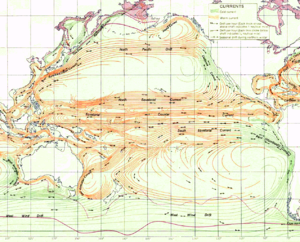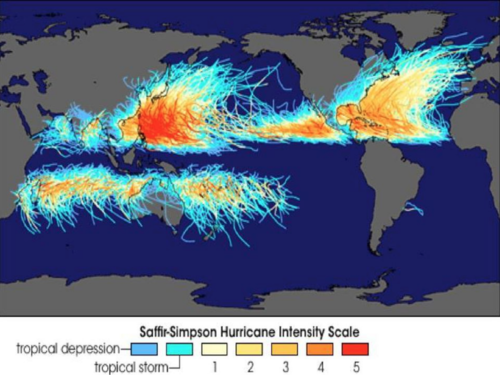Difference between revisions of "Coriolis Effect (Weather)"
Tom Bishop (talk | contribs) |
Tom Bishop (talk | contribs) |
||
| Line 27: | Line 27: | ||
==Counter-Rotating Vortexes== | ==Counter-Rotating Vortexes== | ||
| − | To explain why the hurricanes rotate oppositely from each other point to the fact that Hurricanes develop near the equator, and that at the equator there exists a strong wind current called the Equatorial Counter Current, which is a | + | To explain why the hurricanes rotate oppositely from each other point to the fact that Hurricanes develop near the equator, and that at the equator there exists a strong wind current called the Equatorial Counter Current, which is a strong permanent westerly-flowing wind current. This Counter Current runs in an opposite direction to currents North and South of it. Since the atmosphere is generally characterized as a fluid, we can imagine this as a water current which moves against the flow of the waters around it. |
To explain why the hurricanes rotate in an opposite manner from each other when they develop neat the equator we point to the the following videos, where friction in water creates oppositely rotating vortexes: | To explain why the hurricanes rotate in an opposite manner from each other when they develop neat the equator we point to the the following videos, where friction in water creates oppositely rotating vortexes: | ||
Revision as of 03:59, 10 October 2018
Work in Progress
According to proponents of the Coriolis Effect, in the Northern Hemisphere wind systems rotate counter-clockwise, and in the Southern Hemisphere wind systems will rotate clockwise. This is provided as evidence of the Coriolis Effect, and therefore, as evidence of the diurnal motion of the earth.
Dr. Anantha Aiyyer of NC State University explains that systems should rotate counterclockwise in the Northern Hemisphere and clockwise in the Southern Hemisphere.
https://www.newsobserver.com/news/technology/article103760221.html
“ Q: Why do hurricanes go counterclockwise in the northern hemisphere and clockwise in the southern hemisphere?
A: You can think of a hurricane as a spinning column of air that stretches from sea-level up to about 45,000 feet. Over much of this depth, air flows counter-clockwise in the northern hemisphere and clockwise in the southern hemisphere. To understand why, let’s consider the rotation of the earth. We know that the earth spins along an invisible axis from west to east. But if we look at it differently, something interesting jumps out. Imagine you are hovering above one of the poles and are looking down at the earth. Pick the North Pole and do this thought experiment. In what sense is the earth rotating? Counterclockwise. Now fly to the South Pole and look at the earth and notice its rotation. It will help to use a spinning tennis or basketball to visualize this. It now appears to spin clockwise.
We note that hurricanes spin in the same direction as the earth’s hemisphere (as viewed from the poles) they are located in. This is not a coincidence. The atmosphere is attached to the spinning earth and as a result every column of air is also spinning. When that inherent spin is concentrated (this happens when air convergences into an area) we get rotating storms like hurricanes. As the sense of rotation is opposite in the two hemispheres, this leads to oppositely spinning hurricanes. ”
Prevailing Winds and Trade Winds
"Prevailing Winds" and "Trade Winds" are the world's large permanent wind systems. When we look at the permanent wind currents of the world, we find the counter-clockwise rule of the Northern Hemisphere and the clockwise rule of the Southern Hemisphere to be untrue. Earth's large permanent wind systems are rotating in a manner contrary to the alleged Coriolis Effect.
Prevailing Winds of the Pacific (Click for bigger)
Hurricanes
Coriolis Effect proponents point to the rotation of hurricanes. In the Northern Hemisphere hurricanes rotate counter-clockwise, and in the Southern Hemisphere hurricanes rotate clockwise, thus proving the Coriolis Effect. While researching this claim, we find that it may indeed be generally true for most hurricanes.
Counter-Rotating Vortexes
To explain why the hurricanes rotate oppositely from each other point to the fact that Hurricanes develop near the equator, and that at the equator there exists a strong wind current called the Equatorial Counter Current, which is a strong permanent westerly-flowing wind current. This Counter Current runs in an opposite direction to currents North and South of it. Since the atmosphere is generally characterized as a fluid, we can imagine this as a water current which moves against the flow of the waters around it.
To explain why the hurricanes rotate in an opposite manner from each other when they develop neat the equator we point to the the following videos, where friction in water creates oppositely rotating vortexes:
- Wooden Spoon Stroking Through Water Creates Counter-Rotating Vortexes (1m29s)
- Dinner Plate Creates Counter-Rotating Vortexes in a Swimming Pool (2m20s)
The same general phenomena seen in the fluids of water in the above videos are occurring with the fluids of the air near the equator. When comparing the direction of the vortexes in the above video with the direction of the plate and spoon, to the direction of the Hurricanes and the direction of the Equatorial Counter Current, we find that, indeed, the directions match up. A "Coriolis Effect" is not needed to describe the rotational direction of these systems.
Counter Current Activity Correlation
The following is a study which associates stronger Counter Current activity with the development of hurricanes.
On the role of the North Equatorial Counter Current during a strong El Niño
https://www.ocean-sci.net/14/633/2018/os-14-633-2018.pdf
Abstract: “ An analysis of archived data from the NEMO 1/12th degree global ocean model shows the importance of the North Equatorial Counter Current (NECC) in the development of the strong 1982–1983 and 1997–1998 El Niños. ”
Text: “ The forcing fields show that periods with strong westerly winds occurred at the Equator during the development of both the two strong El Niños studied and the warm pool event ”
Crossing the Equator
Coriolis Effect proponents further claim that hurricanes have never crossed over the equator into the opposing hemisphere. Although we have found articles of instances where storms have crossed, we accept the rarity and point out the following:
- At the equator exists a strong and permanent easterly-flowing current called the Equatorial Counter Current, which is bordered on the North and South by westerly flowing currents called the Northern and Southern Equatorial currents. Such a hurricane would need to defeat these currents in order to make it across.
- Hurricanes are created by these topical wind currents, and are sent spiraling Northward or Southward away from the tropical regions of the equator to cause havoc towards temperate regions of the North or South.
- Hurricanes have relatively short lives of an average of about 9 days.
The above points make it unreasonable for a hurricane to return to its origin and cross the equator to the other side.
Origin of Hurricanes
How do Hurricanes Form?
https://scijinks.gov/hurricane/
“ Hurricanes are the most violent storms on Earth. They form near the equator over warm ocean waters. ”
From https://weloveweather.tv/hurricanes-equator/ we see the following graphic, showing hurricanes originating in the tropical regions of near the equator:
150 years of tropical cyclone tracks through 2006
“ The graphic above clearly reveals that hurricanes (Atlantic basin, E. Pacific), typhoons (W. Pacific), and cyclones (Indian Ocean, Australia) rarely if ever form between 5 deg North and 5 deg South latitudes, respectively. ”
Hurricane Life Cycle
http://hurricanescience.org/science/science/hurricanelifecycle/
“ Most hurricanes follow a similar cycle of development, called a hurricane life cycle. These life cycles may run their course in as little as a day or last as long as a month. The longest-lasting tropical cyclone ever observed was Hurricane/Typhoon John, which existed for 31 days as it traveled a 13,000 km (8,100 mi) path from the eastern Pacific to the western Pacific and back to the central Pacific. There have also been many tropical cyclones that remained at hurricane intensity for 12 hours or less, including the Atlantic hurricane, Ernesto, in 2006. ”
Average Life
http://www.wxresearch.org/family/pg4.html
“ "Average life of a hurricane, determined by time and place of origin and rate of forward movement, is nine days." (TCMC, 1976). ”
http://shopkins.uga.edu/dir/Geog1112/Lectures1112/LECT19TropCyclo.htm
“ Tropical systems have an average life span of from 7-10 days, but may last over 2 weeks. This covers from the first development of a Tropical Disturbance through to when a Hurricane finally dissipates. ”
Wind Currents at the Equator
North Equatorial Current
https://en.wikipedia.org/wiki/North_Equatorial_Current
“ The North Equatorial Current is a significant Pacific and Atlantic Ocean current that flows east-to-west between about 10° north and 20° north. It is the southern side of a clockwise subtropical gyre. Despite its name, the North Equatorial Current is not connected to the equator. In both oceans, it is separated from the equatorial circulation by the Equatorial Countercurrent (also known as the North Equatorial Countercurrent), which flows eastward. The westward surface flow at the equator in both oceans is part of the South Equatorial Current. ”
Equatorial Counter Current
https://en.wikipedia.org/wiki/Equatorial_Counter_Current
“ The Equatorial Counter Current is an eastward flowing, wind-driven current which extends to depths of 100-150m in the Atlantic, Indian, and Pacific Oceans. More often called the North Equatorial Countercurrent (NECC), this current flows west-to-east at about 3-10° North ”
South Equatorial Current
https://en.wikipedia.org/wiki/South_Equatorial_Current
“ Ocean current in the Pacific, Atlantic, and Indian Ocean that flows east-to-west between the equator and about 20 degrees south. In the Pacific and Atlantic Oceans, it extends across the equator to about 5 degrees north. ”
Addendum
We suspect that if all of the the world's wind patterns, wind systems, and wind currents of the earth were traveling in a reverse manner to which they travel, Coriolis Effect proponents would instead be championing the Prevailing Winds and Trade Winds as proof of the Coriolis Effect and the rotation of the earth, while they ignore the hurricanes.


